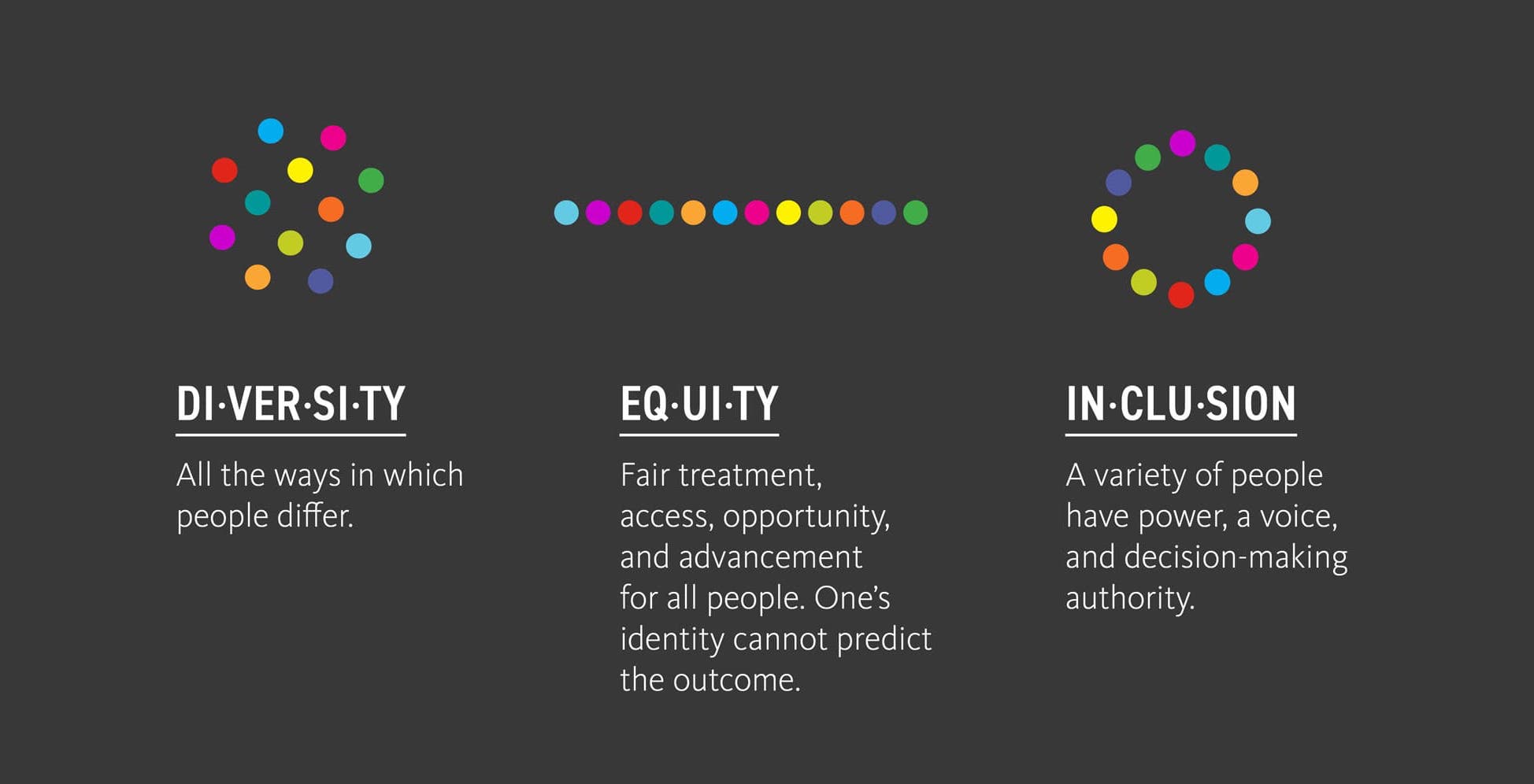Despite the renewed energy around DEI, there remains a noticeable lack of clarity around each of these terms. In some circles, you’ll likely hear one or more of these terms used interchangeably. Elsewhere, you’ll find DEI used as a kind of non-specific catchall, when it might be more productive to hone in on a specific part of this concept for the purposes of identifying improvements and launching initiatives.
So, what exactly is diversity? What do equity and inclusion actually mean? And what is the difference between each term? Before we dig into each one, check out this graphical representation of DEI from Gensler, in which we see that each term has its own definition which, however distinct, is not entirely related from the other two terms:

Source: Inclusion by Design: Insights from Design Week Portland; Gensler
Diversity
There’s a tendency to refer to people, or a person, as “diverse.” Even with the best intentions, referring to people this way feels a lot like euphemism for “outside the majority,” or “different from the dominant group.”
This framing of diversity is misleading at best, because it assumes we’re all the same. At worst, it’s a damaging oversimplification that alienates people, rather than include them. It’s a problem we’ve seen echoed among many job seekers, talent acquisition specialists, and HR professionals.
Blanket treatment of diversity doesn’t work because all perceptions of diversity are the same. In our own experience, we’ve found that some groups, such as millennials, perceive so-called “workplace diversity” as a combination of many different backgrounds. At the same time, older generations tend to view diversity more through the lens of equal and fair representation. It’s important to remember that diversity is less about what makes people different—their race, socioeconomic status, and so on—and more about understanding, accepting and valuing those differences.
Common types of diversity:

We like to conceptualize diversity as an embodiment of a group’s composition, likely made up of many or all of the diversity types listed above. It’s a composite of the various differences represented—and talking to each other—therein.
Take the following Staff Diversity Numbers, 2019 from NPR, for instance. While this annual report might look like a simple breakdown of the “percentage of people represented from a given group,” it’s more like a starting point for understanding how those percentages intersect and impact the company’s culture, morale, and objectives. There are insights embedded within this chart, insights that might help inform new diversity initiatives.

Source: NPR’s Staff Diversity Numbers 2019. NPR
Equity
Whereas diversity refers to all the many ways that people differ, equity is about creating fair access, opportunity, and advancement for all those different people. It’s about creating a fair playing field, to use a familiar metaphor. Here’s a useful illustration of equity from the Northwestern Health Unit:

Source: Equity vs Equality. Northwestern Health Unit
Let’s take the topic of transportation, to use an example so common to corporate environments. Not everyone within an organization will own a car, or even be able to afford public transportation on a daily basis. An organization can create a more equitable environment by accommodating the full spectrum of transportation needs, from policies around start times and working hours to stipends for both automobile and public transportation travel.

Source: Word of the Day. Merriam-Webster
Of course, issues of access, opportunity, and advancement extend far beyond how we get ourselves to work. Women, for example, are historically underrepresented, as are various minorities throughout the United States and the rest of the world. It’s a problem that persists even today (as the data we shared above helps to show).
Successful equity initiatives, then, must build fairness and equal treatment into the very fabric of an organization. This requires a design for creating, maintaining, and protecting equity organization-wide—a framework that supports equitable talent screening, hiring, workplace standards, and so on.
Inclusion
There’s a common misconception that environments in which diversity and equity are priorities naturally beget inclusion. You’ve built equitable practices into your organizational processes, after all, leading to far more diverse, well-represented teams. People have to feel included in a company like this, right?
Not always, as it turns out.
Inclusion is the extent to which various team members, employees, and other people feel a sense of belonging and value within a given organizational setting. The important distinction here is that even among the most diverse teams, there’s not always a feeling of inclusion. Women might be well represented at the senior management level, but still not feel included due to longstanding gender norms, salary discrepancies, and other factors.

Source: CRU-Inclusion-Graphic Community Resource Unit Ltd.
Evaluating an organization’s inclusion starts with empathy. Why? Consider the fact that some 48% of employees believe that respect the most important to creating an inclusive workplace (Quantum Workplace report). That means not only respecting people’s differences but considering the environment more broadly—from their point of view. Namely:
- Balance of experience for less represented groups.
- Barriers to entry both structural and societal that might be at play.
- Blindspots and assumptions that might be working against a more inclusive environment.
Again, it’s useful to consider these aspects of inclusion from the employee’s point of view. Do they feel a sense of community and connection? Do they feel like they contribute on a daily basis? Do they feel a shared sense of purpose with their coworkers and peers?



No responses yet